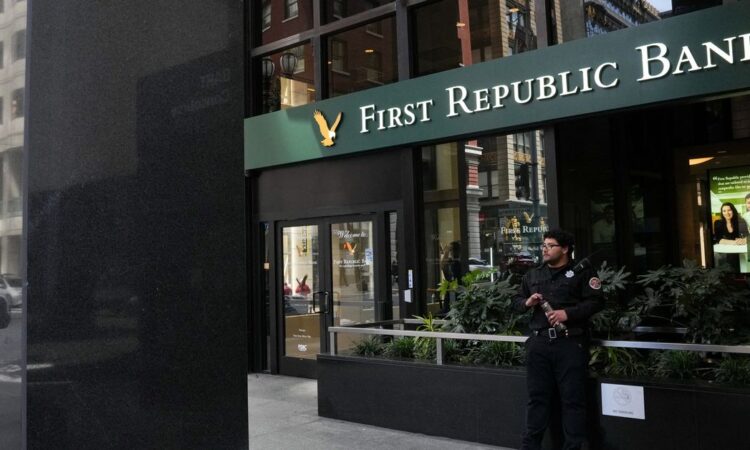
May 1 (Reuters) – JPMorgan Chase & Co (JPM.N) will buy most of First Republic Bank’s (FRC.N) assets in a last-ditch rescue led by U.S. regulators, marking the third major U.S. institution to fail in two months.
The deal, announced early on Monday by regulators who said they had seized First Republic, will see the banking giant take $173 billion of loans, $30 billion of securities and $92 billion of deposits of the failed lender.
There were no details on how much JPMorgan would pay.
San Francisco-based First Republic came under intense pressure after disclosing last week that it had suffered more than $100 billion in outflows in the first quarter and was exploring options.
That also renewed stress on the banking sector, which was reeling from the closure of Silicon Valley Bank and Signature Bank in March, while Swiss lender Credit Suisse (CSGN.S) was bought by rival UBS (UBSG.S) in a state-engineered takeover.
First Republic Bank shares tumbled 43.3% in premarket trading. The stock has lost 97% of its value this year. JP Morgan shares rose 2.7%.
“The wall of worry may ease. Resolving FRC should end the seven-week post SVB bank crisis phase,” Wells Fargo analysts wrote in a note late on Sunday before the deal was announced.
“Mid-cap bank earnings have shown that deposit concerns are isolated to a handful of banks, and the challenges at SIVB and FRC are not indicative of the group’s (mid-sized banks’) resiliency.”
JPMorgan was one of several interested buyers including PNC Financial Services Group (PNC.N), and Citizens Financial Group Inc (CFG.N), which submitted final bids on Sunday in an auction being run by U.S. regulators, sources familiar with the matter said over the weekend.
PNC shares were 2.5% lower in premarket trading.
The California Department of Financial Protection and Innovation said it had taken possession of First Republic and the Federal Deposit Insurance Corporation (FDIC) would act as its receiver.
The FDIC estimated in a statement that the cost to the Deposit Insurance Fund would be about $13 billion. The final cost will be determined when the FDIC terminates the receivership.
STEPPING UP
The rescue comes less than two months after a deposit flight from U.S. lenders forced the Federal Reserve to step in with emergency measures to stabilize markets. Those failures came after crypto-focused Silvergate voluntarily liquidated.
“Our government invited us and others to step up, and we did,” said Jamie Dimon, Chairman and CEO of JPMorgan Chase. “Our financial strength, capabilities and business model allowed us to develop a bid to execute the transaction in a way to minimize costs to the Deposit Insurance Fund.”
JPMorgan said it expected to achieve a one-time, post-tax gain of approximately $2.6 billion after the deal which did not reflect an estimated $2 billion dollars of post-tax restructuring costs likely over the next 18 months.
It said the bank would be “very well-capitalized” after with a common equity tier one (CET1) ratio consistent with its first quarter 2024 target of 13.5%, and maintain healthy liquidity buffers.
The failed bank’s 84 offices in eight states will reopen as branches of JPMorgan Chase Bank from Monday, according to the JPMorgan statement.
JPMorgan has been on an acquisition spree since 2021, acquiring more than 30 companies in deals worth more than $5 billion combined.
In recent years, U.S. regulators have been slow to approve large bank deals. The Biden administration has also cracked down on anti-competitive practices.
Reporting by Saeed Azhar, Nupur Anand and Tatiana Bautzer in New York; Editing by Stephen Coates and Kirsten Donovan
Our Standards: The Thomson Reuters Trust Principles.






